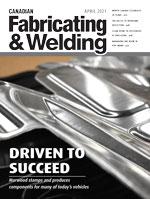Technical chemist
- FMA
- The Fabricator
- FABTECH
- Canadian Metalworking
Parts cleaning for a superior finish
How vapour degreasing can help prepare part surfaces for finishing processes
- By Venesia Hurtubise
- April 27, 2021
- Article
- Metal Finishing

Modern cleaning fluids offer high solvency to clean and displace production debris and soils. Images: MicroCare
The perfect finish is crucial to producing quality metal parts. Failure to prepare part surfaces properly not only detracts from the parts’ final appearance, but it can negatively impact anodizing, painting, coating, plating, and welding. The down-line effect of poorly prepped parts can include a decline in production, parts quality, and parts reliability.
An effective way to get a high-quality surface ready for finishing is cleaning. Cleaning can successfully dissolve or displace common contaminants without damage and leave surfaces ready for finishing.
Simpler Cleaning for Complex Parts
Many finished metal parts are subject to high cleanliness standards and must pass black light inspection, particle count tests, or water break analysis to ensure they meet quality requirements. Also, parts are getting smaller and more complex. Intricate geometries, awkward shapes, and internal blind holes can make them difficult to clean.
Adding to the cleaning difficulty are the ever-changing environmental regulations placed on metal fabricators today. Cleaning fluids must not only clean surfaces effectively, they must also meet strict regulatory requirements and environmental sustainability standards.
Contaminants Vary
Parts are exposed to an array of contaminants throughout manufacturing. This can include machining oil, grease, lubricants, polishing pastes, adhesives, wax, marking inks, fingerprints, and other production debris. To achieve a superior finish, it’s important to remove these soils from the part surface before any finishing work starts. One of the most efficient cleaning methods to achieve perfectly prepped parts is vapour degreasing, which has a high throughput and can be automated into standard production lines.
Vapour Degreasing
A vapour degreasing machine is a closed-loop system that uses a specialized, low-boiling, non-flammable fluid as the cleaning agent.
The vapour degreasing machine contains two chambers: the boil sump and the rinse sump. Soiled parts are immersed in the boil sump to dissolve or lift the soils from the parts’ surface. In some instances, ultrasonic agitation adds extra cleaning muscle. As the parts lift from the boil sump, they undergo a brief rinse in the rinse sump filled with pure, uncontaminated fluid, or inside the rinsing fluid vapours. After a typical cycle of about six to 20 minutes, the parts come out clean, dry, and ready for finishing.
Vapour Degreasing Fluids
Most modern vapour degreaser cleaning fluids comprise a mixture of ingredients, including hydrocarbons like mineral spirits, or alcohols like isopropanol and ethanol. How the ingredients combine determines the cleaning fluid’s effectiveness and its material compatibility. The vapour degreaser can use a single cleaning fluid, or fluids can be mixed, blended, or custom formulated to remove a specific soil from a specific substrate to maximize cleaning effectiveness.
These fluids are effective at trapping and removing soils from the most complex and intricate part geometries. Their chemical properties help in the overall cleaning process. For example, modern cleaning fluids typically have a low surface tension and a very low viscosity. This allows them to penetrate and clean very tight spaces, such as inside blind holes or in the crevices between stacked parts. Most vapour degreasing fluids also are very heavy and dense, typically 20 to 40 per cent heavier than water, which aids in dislodging particulate from the parts. And although they are powerful cleaners, the cleaning fluids are designed to work without causing damage, even on delicate parts.
Sustainable Parts Cleaning
Parts cleaning fluids now face increasing numbers of environmental regulations regarding both composition and disposal. Vapour degreasing developers have addressed both of these concerns.
Many modern parts cleaning fluids have improved environmental properties including a very low global warming potential to help reduce greenhouse gas effects. They also have zero ozone depleting potential and low VOC formula content. This allows them to meet strict regional air quality regulations and follow global environmental directives. Many are not considered to be hazardous air pollutant. The fluids typically are based on hydrofluoroethers or hydrofluoro-olefin technology, making them suitable replacements for N-Propyl Bromide or trichloroethylene, which cause air and groundwater quality concerns.
The fluids clean inside the vapour degreaser for hundreds of cycles before needing to be refreshed or replaced. Additionally, it concentrates the soils as it works. This reduces waste generation and lowers hazardous waste disposal costs. And the vapour degreasing process uses no water and little electricity to clean.
Cleaning is a critical step to achieve a quality part surface finish. By using a vapour degreaser and modern cleaning fluids, the cleaning process can be simple, consistent, and sustainable.
Venesia Hurtubise is a technical chemist at MicroCare, 595 John Downey Dr., New Britain, CT 06051, 860-827-0626, www.microcaremed.com.
About the Author
subscribe now


Keep up to date with the latest news, events, and technology for all things metal from our pair of monthly magazines written specifically for Canadian manufacturers!
Start Your Free Subscription- Industry Events
Automate 2024
- May 6 - 9, 2024
- Chicago, IL
ANCA Open House
- May 7 - 8, 2024
- Wixom, MI
17th annual Joint Open House
- May 8 - 9, 2024
- Oakville and Mississauga, ON Canada
MME Saskatoon
- May 28, 2024
- Saskatoon, SK Canada
CME's Health & Safety Symposium for Manufacturers
- May 29, 2024
- Mississauga, ON Canada





















